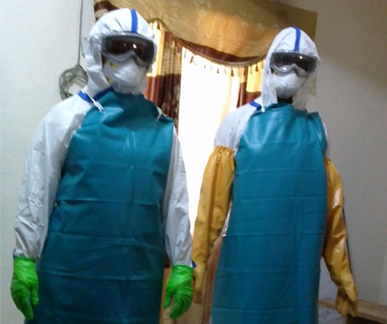Maria Bassou, Emily Gooding, Marianne Jahre
Partner: Avenir Analytics
The recent Ebola outbreak in Liberia prompted a vast international response from various governments, NGOs, and UN organizations. In the case of Personal protective equipment (PPE) for healthcare workers responding to a crisis, the implications are clear. There are few global manufacturers and suppliers of high-protection-level PPE. The ability of the PPE supply chain to provide adequate and consistent supply when there is a large spike in demand has not been well-considered. Humanitarian logistics literature rarely considers infectious disease outbreaks as possible humanitarian crises while epidemiology literature assumes perfectly responsive supply chains. When demand for specific types of PPE spikes during an outbreak, this limited supply is further constrained. PPE procurement among responding organizations and governments becomes a competitive and time-intensive activity. This procurement is further complicated when epidemiological forecasting models produce confusing or unreliable results. The failure to connect these complicated pictures of expected demand with PPE supply chain strategies and deployment can result in delayed or inappropriate PPE procurement in infectious disease outbreaks, as was the case in the 2014 West Africa Ebola outbreak.
This ad-hoc effort was confronted with a significant challenge when required to coordinate the personal protective equipment (PPE) necessary for response. The Ebola PPE Standards Project tracks the evolution and dissemination of PPE standards throughout the Ebola crisis in Liberia, and identifies ways in which the standardization of medical response equipment can be improved for future outbreaks.
This effort uses a mixed methods approach – an exploratory case study and system dynamics model – to bridge the gap between these two fields. It provides one approach for connecting epidemiology and supply chain research. An explanatory case study of the 2014 West Africa Ebola outbreak is used to analyze the PPE supply chain and its in-crisis functionality. We gather primary data using semi-structured interviews with supply chain actors and analyze that data using qualitative coding analysis. The system dynamics model is developed based on the results of the case study to offer insight as to how the PPE supply chain could be improved to better respond to future outbreaks. Several scenarios are simulated to test the effects of various supply chain improvement strategies. Relationship-building between supply chain actors, unconstrained shipping channels, flexible funding pools, and pre-positioning are all found to be effective supply chain improvement strategies.
For more about this publication, please refer to Emily Gooding’s thesis, A Mixed Methods Approach to Modeling Personal Protective Equipment Supply Chains for Infectious Disease Outbreak Response.

